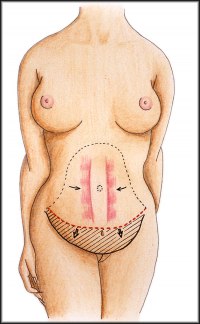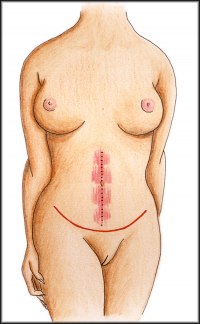Tummy Tuck
AbdominoplastyThe operation is recommended for women or men after a major weight loss or for women after pregnancy to firm the abdomen, reduce fat deposits and remove excessive skin.

Abdominal plastic surgery offers a solution by flattening the slack skin- and tightening muscles of the relaxed abdominal wall, which frequently occurs after pregnancy or a distinct weight loss. If needed, excess subcutaneous fatty tissue is removed as well. The appearance and functional results of the surgery are very good although at the cost of scars that are inevitable in order to remove excessive skin. It leaves a permanent scar. However, it will fade with time and its quality differs per individual.
Abdominoplasty is not only an aesthetic surgery but it also provides a solution to functional deficiency of the abdominal wall, i.e. inferior rectus muscles diastases. The surgery not only brings about a better appearance and function but it also stops the slackening process of the abdominal wall. The initial and a very important step to be taken before any decision on the surgery is made is a personal consultation with an experienced plastic surgeon. A good state of health is a prerequisite, which determines the upper age limit for this procedure. This surgery is not recommended when pregnancy is planned. This procedure can be performed on men to a degree if the skin slack is more marked.

Surgery and Postoperative Period
The operation is performed under general anaesthesia. The incision and the resulting scar runs closely above the pubic hair within the entire width between the hip bones. Consequently, the scar is situated in way to be covered with underwear along the entire length. This approach will bring about the best general effects. In addition to removing any excess slack skin, the surgery also includes the navel transfer to a new position, reinforcement of the abdominal wall by suture of diastases of the inferior rectus muscles and subcutaneous fatty tissue removal if required.The stay at hospital is typically 2 -3 days.
The patient must rest at home for about a week. The bandage should be changed after discharge one week after the operation. Following check-ups or new dressing as required should be fixed individually in accordance with the healing progress. Rest is recommended for 14 days after the surgery, and the patient may get back to a full workload after about 6 weeks of gradual recovery. In case of any subjective complaints (conspicuous pain, pressure) or any complications (persistent temperature above 38°, bleeding with the blood oozing in the bandage) it is required that the patient reports to this department for check-up or contacts our doctor on the phone. Tugging and impaired tenderness in the affected areas are common side effects and they will be adjusted in a couple of weeks. The data presented is based on a common post-operation course. However, a recovery is an individual process depending not only on healing abilities of every individual body, but also on every patient's conscientiousness. The patient is expected to set such conditions for a period of several days after her operation to be able, in case of any subjective problems or complication, to come as soon as possible for examination to our department. A positive operation result and mutual satisfaction is in your interest as well as in ours. Mutual trust and co-operation of the patient with surgeon is the vital precondition.








